Wireless LAN (WLAN)
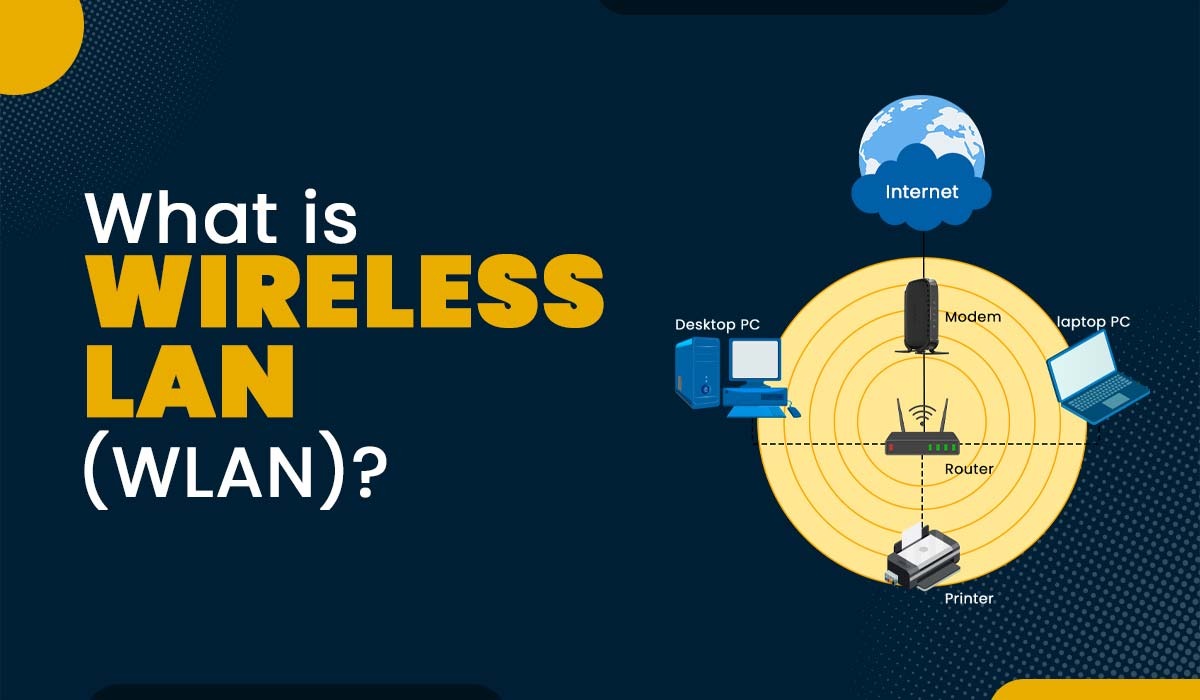
The shift from wired to wireless LANs (WLANs) is a result of people’s growing need for portability and adaptability in their everyday lives. WLANs are widespread in the modern world. Wireless LANs are available everywhere, from homes to businesses to cafes to many public spaces, guaranteeing that we will always have access to the internet. WLANs allow us to stay online even while we’re in transit. Because of the freedom it gave its users to roam about while still being productive, smart gadgets have become more popular. Before getting into more details, let’s first understand what WLAN really is. A Wireless Local Area Network (WLAN), also known as a Wireless LAN, is a network comprising two or more computing devices that communicate through radio waves without the need for physical connections. This stands in contrast to a local area network (LAN) that employs wired connectivity, whereby every computer within the network is physically linked to the network switch or hub via an Ethernet cable. The majority of WLANs are established on the IEEE 802.11 standard. Wireless LANs are further classified into two categories, these are: Ad hoc networks are formed by a group of wireless nodes that establish peer-to-peer communication. The ad-hoc mode has been designed to allow communication only among clients within the transmission range, i.e., within the same cell. If a client wants to communicate outside the cell, then it’s a must that one of the cells acts as the gateway and performs routing. Wireless LANs with infrastructure are equipped with a backbone that operates at high speeds and can be wired or wireless. Access points serve as the intermediary between wireless nodes and the wired backbone. The utilization of access points allows the proficient transfer of network resources among wireless nodes. Before transmitting information, wireless devices such as clients and access points are required to establish a relationship or association. Data exchange between two wireless stations can only occur once an association has been established. In the 1970s, researchers began exploring wireless networks for communications, and in 1971 the world’s first wireless communications computer, ALOHAnet, was developed by Professor Norman Abramson of the University of Hawaii. It transmitted data wirelessly between the Hawaiian Islands, but WLAN cost more and had much lower speeds, so it was used only as an alternative to cable where cabling was difficult or impossible. This continued until the 1990s but in October 1997 it became a protocol as 802.11 (a technology term that refers to Wi-Fi) which was approved by the Institute of Electrical and Electronics Engineers (IEEE). In 1999, WLAN was introduced to the public with 802.11a and b support with speeds up to 54 Mbps and 11 Mbps, respectively, which was low. However, it became acceptable due to wireless communication in mobile phones and laptops. As technology has changed over time, mobile phones and laptops launching with Wi-Fi usage have become more standardized for both business and personal use. So, in 2003, 802.11g was approved with speeds up to 54 Mbps in the 2.4 GHz space. In 2009, a new version was approved which was 802.11n which operates in both 2.4 GHz and 5 GHz bands with a data transmission rate of 600 Mbit/s. By far most of the new routers are using both band wireless which helps in data communication without the congested 2.4 GHz band, as these are also transferred to Bluetooth devices and microwave ovens. Whereas the 5 GHz band allows more devices to share space due to more channels compared to 2.4 GHz. Currently, we are in the world of 802.11ax which was introduced in 2021 and is the 6th generation (the latest in the series) which is now being deployed on many devices every year. WLANs are utilized in different circumstances and serve their purpose. Networking and internet services are seen as essential in modern business computing. There is a growing trend of LAN users transitioning towards mobile usage. Mobile users necessitate network connectivity irrespective of location as they seek simultaneous access to the network. Wireless LANs allow users to access shared information without the need for physical connections to their systems, thereby eliminating the need for network managers to install cables and other equipment to set up networks. The significance of mobile connectivity is often overlooked; however, it becomes especially critical when one is faced with urgent needs but lacks access to a WLAN. Understanding the functioning of WLAN is straightforward. The operational principles of LAN networking are nearly identical. The only difference is that WLAN allows the connection of devices to a network without the need for a physical cable. Wireless Local Area Network (WLAN) employs radio frequency waves to help with the transmission and reception of data among various devices, such as a wireless router and a laptop. Radio waves are commonly known as radio carriers due to their primary role of transmitting energy to a distant receiver. The radio carrier overlays the transmitted data, thereby allowing its precise retrieval upon reception. The process is commonly known as modulation. In a wireless local area network setup, a transceiver device, commonly referred to as an access point, establishes a connection to the wired network via standard cabling from a fixed position. The access point functions as an intermediary device that allows the transfer of data between the WLAN and the wired network infrastructure by receiving, buffering, and retransmitting the data. A single access point can handle a limited number of users and can operate within a distance from under one hundred to multiple hundred feet. Typically, the access point, along with its attached antenna, is installed at an elevated position. However, it may be situated in any feasible location that achieves the desired radio coverage. Wireless LAN adapters serve as the medium through which end users gain access to the wireless LAN. These adapters are available in the form of add-on cards for notebook or palmtop computers, as cards for desktop computers, or as integrated components within hand-held computers. WLAN adapters allow a communication interface between the client’s network operating system (NOS) and the airwaves through an antenna. Here are the components of WLAN Architecture – Stations are elements of a network that allow wireless communications. They can be either access points or endpoints and both have different network addresses. BSS is a group of stations integrated with the network and called independent BSS (IBSS) in ad hoc networks. A group of BSSs connected to a network with multiple access points is known as an Extended Service Set (ESS). In ESS, access points are connected to the distribution system with wired or wireless connectivity. Wireless distribution systems (WDS) use mesh or their own WDS protocol. And connecting geographically separated access points in a unique form of radio transmission called fixed wireless. The access point acts as a base station that allows connectivity to other stations and the “access” refers to both the station’s network connectivity and Internet access as many routers also act as modems. Access points can be connected using an Ethernet cable or wirelessly across an ESS. The bridge acts as a connector between the WLAN and the LAN or access point. An endpoint is an end-user station such as a computer, printer, mobile device, or Internet of Things (IoT) device that is used by users. IEEE 802.11 is the standard protocol for wireless local area networks that make it possible to connect securely to high-speed wireless networks while still having mobile access to network infrastructure. Before the advent of this technology, we needed to be connected with cables to the LAN to enjoy the benefits of a fast connection speed while using a network. Several WLAN standards and modes have been designed throughout time by multiple organizations in the business world. The following diagram illustrates many of the most popular WLAN modes and standards. 802.11 was first developed in 1997, and after that various updates are developed as per the requirements. Some of the benefits associated with the Wireless LANs are: Here are some disadvantages of Wireless LAN – WLANs can be used for different purposes, this includes connecting computers, smartphones, tablets, printers, and other devices in homes, offices, schools, and public places. Although the terms WLAN and Wi-Fi are often utilized interchangeably, it is important to note that these two wireless technologies have some differences. Wireless Local Area Network (LAN) employs radio frequency technology to establish connections between nodes. Wi-Fi, on the other hand, is a specific type of WLAN. There are different types of WLANs based on their architecture, frequency band, and standard. Some common types of WLANs are Infrastructure mode and Ad-hoc mode. One of the most common examples of wireless LANs is the home network. With it, a user can use the internet for various purposes, such as sharing files or printing documents. Wireless LANs (WLANs) are networks that use radio waves to connect devices without cables. WLANs allow users to move around within a limited area, such as a home, office, or campus, and stay connected to the network. In this blog, we have discussed the fundamentals of wireless LANs, their working, benefits, disadvantages, and different standards. We hope you like the information. If you want to learn Wireless LANs in detail, you can also Enrol in our CCNA Program.Introduction
What is Wireless LAN in computer networks?
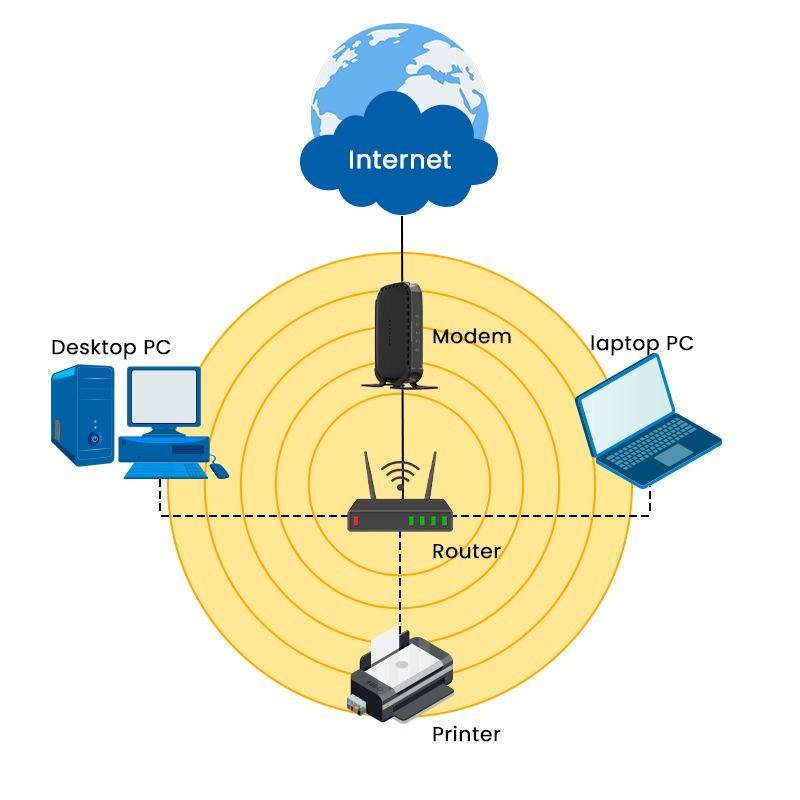
1. Ad-hoc Wireless LANs
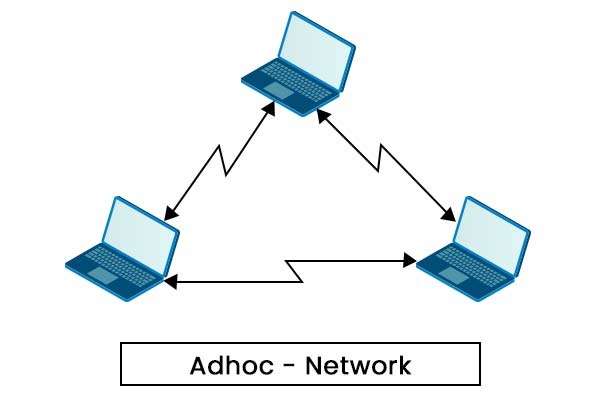
2. Wireless LANs with Infrastructure
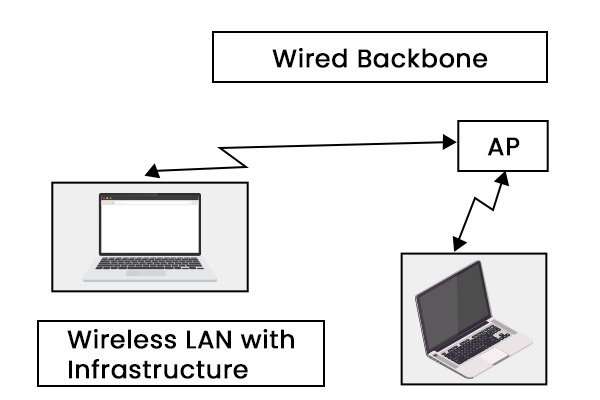
History of Wireless LANs
Purpose of WLAN
How Does Wireless Local Area Network Work?
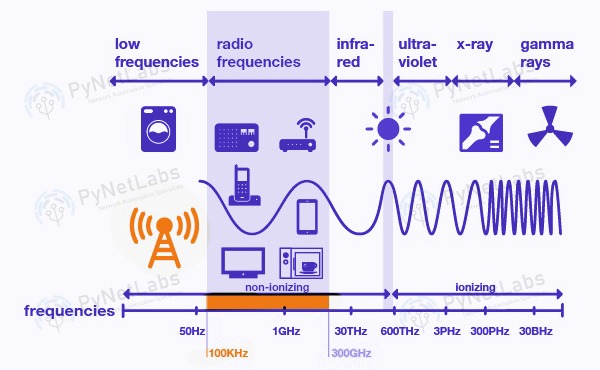
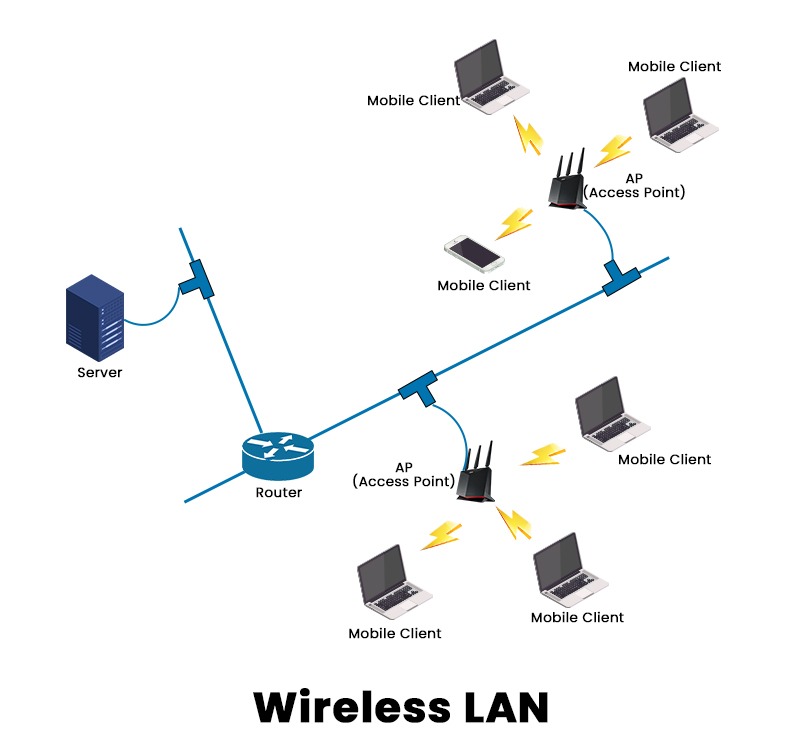
WLAN architecture
Stations
Basic Service Set (BSS)
Distribution system
Access point
Bridge
Endpoint
Wireless LAN Standards and Modes
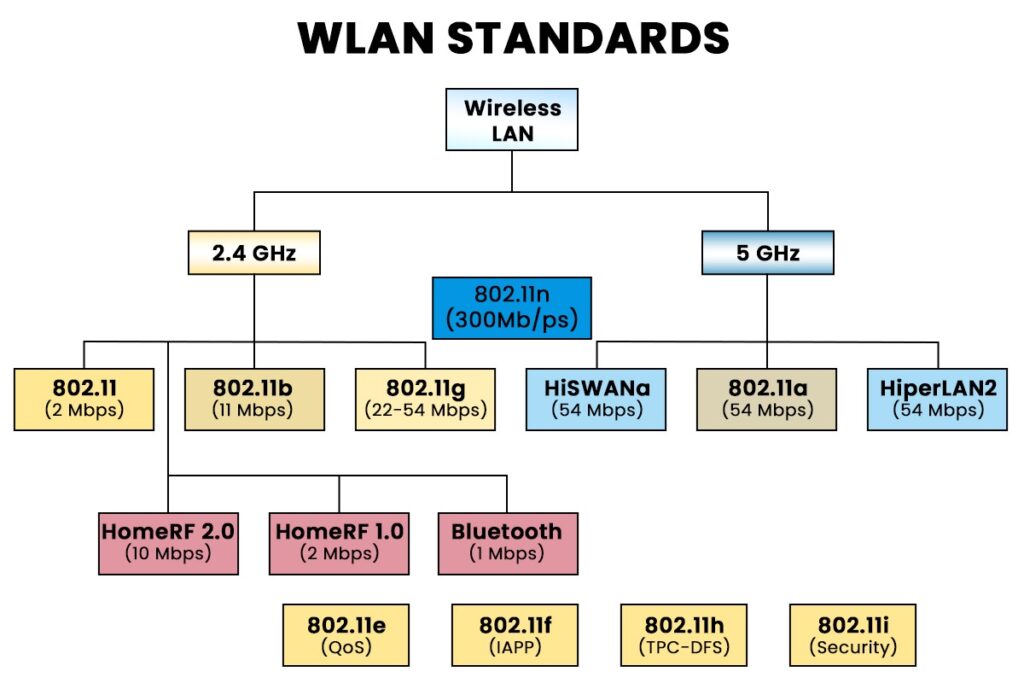
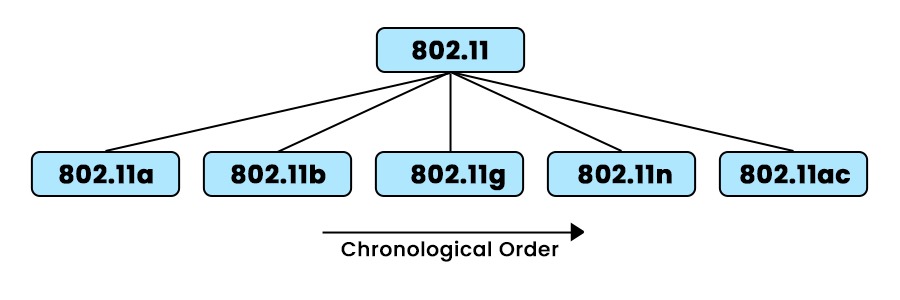
Advantages of Wireless LAN in Computer Networks
Disadvantages of Wireless LAN
Frequently Asked Questions
Q1 – What is a wireless LAN used for?
Q2 – Is wireless LAN same as Wi-Fi?
Q3 – What are the types of wireless LAN?
Q4 – What is an example of wireless LANs?
Conclusion







